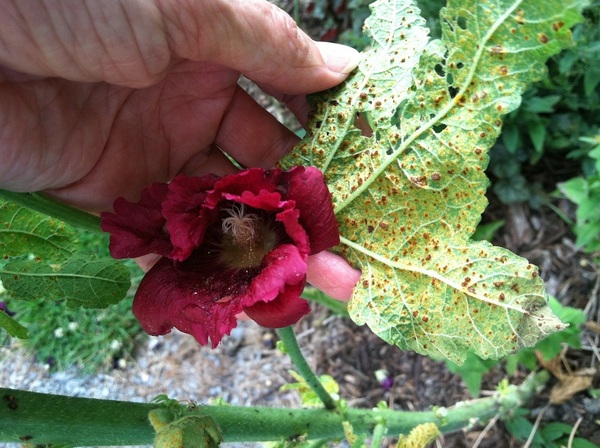

You may have gotten the impression from last week’s column on hollyhocks that I was holding back; that there was something that I wasn’t telling you.
There was.
While these magnificent garden plants can be absolutely gorgeous, even sexy, they are not without their problems. And while I wouldn’t stop from tempting you to grow them, some self control may be in order.
Hollyhocks and their pretenders are easy enough to grow, and the first year they always do great. It’s in the second year that things can go downhill, so you need to know what to expect and how to cope with the problems. The issues fall into two categories: insects, of which there are four, and disease, of which there is one.
In the insect category we have aphids, spider mites, whitefly and Japanese beetles. The secret here is to know where and when the insects are likely to occur. With this knowledge, controls as simple as sprays of water and a tin can should do wonders.
Aphids begin to show up as soon as the plants gain some height and the days become warm. In some years they can show up in late April but they be around in May for sure. Even before the flower buds emerge, they begin to congregate on the undersides of the leaves. And as the buds are formed, they migrate toward these delicacies.
Aphids are social and occur in groups. Spray them with water (forceful but not strong enough to damage the leaves) to simply knock them off the plant.
The same control can be used when spider mites show up later in the summer during hot and dry spells. These are tiny pests and not easily seen with the naked eye.
Unfortunately, once their damage is seen— in the form of stippled and yellowing spots on the leaves—the damage has already been done. But again, early sightings and sprays of water on the undersides of the foliage early in the day simply wash them away.
Whiteflies may be the hardest to control as the slightest wisps of wind cause them to take to the air and evade control. The only way to really knock them down is with insecticidal sprays that come into direct contact with them. This is best done early in the day when they are a bit lethargic and not easily excited.
Japanese beetles show up once summer is well established and are around for about a month. Neem oil sprays applied to the foliage when these beetles are first noticed can have a deterrent effect. While thought to be a feeding disrupter, neem oil is not a contact insecticide so you can’t spray and expect the beetles to drop to the ground. Japanese beetles can also be hand-picked and dropped into a can or plastic bag that goes into the trash.
So, while there are insect issues, they are not at all insurmountable and water gives good control of at least two of the problems. But, water can also be an issue on hollyhock foliage as you’ll see.
But the big problem with hollyhocks is not an insect. It’s rust. No you can’t scrape it away, you can’t spray on some WD-40 and you can’t oil it to make it better (though one oil may help).
This rust is actually a disease, a fungus that goes by the name of
puccinia malvacearum
. I find this to be a fascinating disease. It’s been studied for ages, and no matter what you may read, there is no hollyhock that is immune to it. Some may be resistant, but none are immune.
Rust shows up on the undersides of the leaves of hollyhocks as small raised orange-yellow spots. It’s noted as yellow spots on the upper sides of the leaves but most of the action takes place underneath.
Because there is a process involved in the fungus attaching to the plant and maturing it rarely shows up during the first year of growth, though it may become obvious late in the first season. The spores then overwinter on the stems that aren’t removed or on leaves that overwinter close to the ground.
Early the following year, they begin to grow and multiply to the point where by then end of the season the plant looks quite unsightly. It’s rarely a fatal disease but the beauty of the plant is so diminished and unsightly that it can be quite depressing.
Rust can come from contaminated seed, contaminated overwintering foliage and from other plants in the
malvaceae
family that are growing nearby where the disease is present but not expressed as noticeably as on the hollyhocks. As an example, it often can be found on
alcea zebrina,
though on this plant it displays only as small yellow spots, but the fungus that is being produced by these spots can fully contaminate any nearby hollyhocks as the spores can be transported by wind and rain.
Good garden sanitation is key to keeping rust under control. Don’t allow infected leaves to drop to the ground and spread the spores. Cut them off affected plants and throw them away (not in the compost pile). Don’t water your hollyhocks from overhead, only at the base. And the advice you may least like is to control you hollyhock plantings. Don’t grow them in the same spot all the time. Grow them for two or three years then take a break of two or three years before bringing them back into the garden.
Some sprays are effective in controlling rust but it’s a tough battle. Garden sulfur sprays can be helpful and sprays of neem oil may also be effective when used on a strict schedule once any sign of rust is noticed.
Varieties of hollyhocks known to show some resistance to rust are Happy Lights, Pastorale, Black Knight (
alcea nigra
) and Antwerp Mixed. These are mostly singles, which points to something in the chemistry of the single varieties that thwarts the disease.
My advice? Grow them. Clean up the foliage at the end of the season and grow them for only two or three years then take a two to three year break before planting them again. Get the seeds, order the plants or buy them at a garden center.
Hollyhocks can be the most stately garden plants and even make good cuts. And of course, keep growing.
 More Posts from Andrew Messinger
More Posts from Andrew Messinger